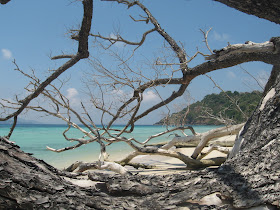 We've been eating fresh fish every day, but they have been single meal size fish that Sten has caught by rod or by speargun. There are plenty of fish here, but our trolling lines have attracted very little interest. The highlight of our motorsail north from Little Andaman to the Cinque Islands was catching a big King Mackerel on our marlin lure. Gutting and steaking a big fish once to produce many meals worth of protein was such a nice change for Sten from having to catch and clean a fish for every lunch and dinner.
We've been eating fresh fish every day, but they have been single meal size fish that Sten has caught by rod or by speargun. There are plenty of fish here, but our trolling lines have attracted very little interest. The highlight of our motorsail north from Little Andaman to the Cinque Islands was catching a big King Mackerel on our marlin lure. Gutting and steaking a big fish once to produce many meals worth of protein was such a nice change for Sten from having to catch and clean a fish for every lunch and dinner.While parked in front of yet another endless stretch of white sand beach at South Cinque, Sten spent the morning in the engine room installing an alternator cutout switch while I cleaned Mata'irea's waterline. Then he took a turn in the water, cleaning growth off of the prop and strut, while I did some cooking. We've been covering so much territory (our route has now taken us through about 3/4 of the Andamans) that we haven't been paying as much attention to routine boat maintenance as we usually do. But with a long passage ahead of us, our focus has shifted back onboard as we tackle pre-departure projects.
 From South Cinque, we made a short hop to North Cinque, where we did a little snorkeling and spent some time tracking down our replacement watermaker brushes via satphone. After just one night at North Cinque, we headed for Chiriatapu, a lovely little protected bay, just 12 miles from Port Blair. I spent our day here tackling a mountain of laundry, rinsing our snorkeling gear, cleaning out the fridge and making pancake mix for passage. Meanwhile, Sten installed a padeye that we've been carrying around with us for two years in the cockpit for the watchkeeper to attach his or her harness to. Then he installed a hold-down latch on the companionway ladder, so that it can't migrate in big seas. After that, he created a plug for the transom shower and sealed the hawse pipe on the bow to reduce the number of ways that water can get into the bilge. Finally, he installed a latch to allow us to lock the companionway hatch from the inside, to keep it from sliding open if we get pooped by a big wave. Before lining the v-berth with baskets full of fresh provisions, we dug out the storm jib. If it seems like our pre-passage preparations have taken a more drastic bent than usual, that's because we are, quite literally, battening down the hatches.
From South Cinque, we made a short hop to North Cinque, where we did a little snorkeling and spent some time tracking down our replacement watermaker brushes via satphone. After just one night at North Cinque, we headed for Chiriatapu, a lovely little protected bay, just 12 miles from Port Blair. I spent our day here tackling a mountain of laundry, rinsing our snorkeling gear, cleaning out the fridge and making pancake mix for passage. Meanwhile, Sten installed a padeye that we've been carrying around with us for two years in the cockpit for the watchkeeper to attach his or her harness to. Then he installed a hold-down latch on the companionway ladder, so that it can't migrate in big seas. After that, he created a plug for the transom shower and sealed the hawse pipe on the bow to reduce the number of ways that water can get into the bilge. Finally, he installed a latch to allow us to lock the companionway hatch from the inside, to keep it from sliding open if we get pooped by a big wave. Before lining the v-berth with baskets full of fresh provisions, we dug out the storm jib. If it seems like our pre-passage preparations have taken a more drastic bent than usual, that's because we are, quite literally, battening down the hatches.The weather patterns across the North Indian Ocean are very predictable. For centuries Arab and Malay traders relied upon the the well-defined nature of the monsoon seasons to safely ply their trade across these waters. But, as Jimmy Cornell wrote in a 1992 article on Indian Ocean passage planning for Cruising World, "the flip side of this regularity is that plans have to be adhered to strictly or one risks having to fight winds and current to reach the desired destination." As usual, we are way behind the rest of the yachts heading across the North Indian this season. The transition season to the Southwest monsoon is now upon us. As a result, our next passage is going to be anything but boring. Stay tuned.

No comments:
Post a Comment